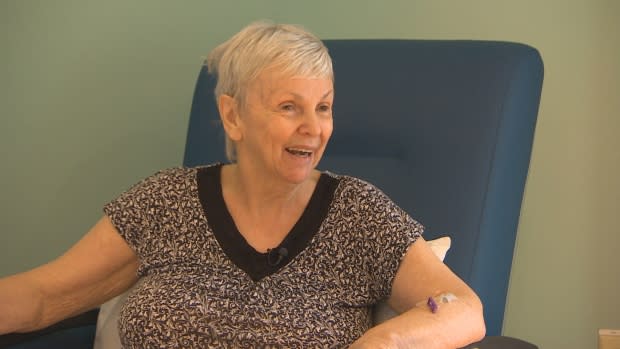Finally some good news for N.S.'s knee and hip surgery wait-list
After years of trying, the Nova Scotia Health Authority says it has managed to put a dent in a longstanding problem: it has finally reduced the number of people on its wait-list for hip and knee surgeries.
This comes as a new province-wide approach is being rolled out to get hip and knee patients out of hospital faster, with measures that range from near-immediate post-surgery group exercise classes to using recliner chairs in addition to beds.
It's believed the approach will help improve the wait-list situation further by streamlining the process, although the results of the latest changes won't be clear for at least six months.
"It's a real shift in thinking, a shift in design," said Dr. Marcy Saxe-Braithwaite, the health authority's senior director of perioperative and surgical services.
"Lots of government money goes into reducing wait times, but if it's not sustainable it doesn't last."

At the beginning of the last fiscal year, the health authority had 3,779 patients waiting for hip and knee surgeries. A year later, it had reduced that number by 4.6 per cent, the first time officials say that's happened in "many years."
Last year, the health authority announced it would use an additional $6.4 million in the health-care budget to hire four surgeons, four anesthesiologists, and more support staff for hip and knee surgeries.
But while wait times for such surgeries are down, they are still triple the national standard of six months.
Grand Pré resident Edie Lloyd went on the waiting list for a replacement of her right hip in July.
"I'm to the point where I'm not really doing anything because of the pain," said the 59-year-old.
Lloyd said she was told she would have a wait time of between eight to 12 months, but she's discouraged she still doesn't have an exact date for surgery.

She said before her hip pain increased she was an active volunteer, a weekly churchgoer, took an aquafit class three times a week, and attended a weekly yoga class.
"I'm struggling getting any activity in, which is counter-productive. You're on the teeter-totter of the pain goes up, and your activity level goes down," she said. "Then you get confined and you start to feel depressed, so it just affects everything."
The health authority said it's working on a two-step process to reduce wait times. The first stage is to funnel patients to "orthopedic assessment clinics" where nurses and physiotherapists answer questions and help strengthen patients before surgery.
On Oct. 15, it began the second stage of its plan. Staff encourage patients to get moving in group exercise classes almost immediately after surgery.
Marlene MacInnis had her left knee replaced at the QEII Health Sciences Centre in Halifax on Tuesday afternoon and by Wednesday morning was in a physiotherapy class doing strengthening exercises.
"That makes me feel good that I did them. I never thought in the world that I would be able to do them the day after, but anyway I was," MacInnis said. "I won't tell you it's not sore."

Patients are encouraged to wear their own clothes instead of hospital gowns, and staff place them in special recliner chairs soon after surgery to encourage them not to lie down in bed.
Patients typically stay between a day and a half and three days on the unit, but the goal is to be able to send most patients home the same day as their surgery, thus clearing the beds for more patients.
"They're doing really well, and there's a whole different feel on the unit," said Angela Bransfield, the health service manager for an orthopedic unit at the QEII Health Sciences Centre.
"Before this model they would have had Johnny shirts on, they would have not been up and moving as quickly. We would have been doing therapy in their room with them, and if they were feeling not quite so well maybe we wouldn't make them move that day. But there's more of an incentive to get people moving and have people buy into that."
Saxe-Braithwaite moved to Nova Scotia from Ontario specifically to work on changing the system to reduce wait times. The new model, she said, is meant to be a better experience for patients.
"Seeing the patients and talking to the patients on their way to exercise class actually gives me goosebumps," she said. "It's so rewarding to see patients up in a chair, happy, feeling like they've had a different experience this time."

The health authority has hired more than 100 people to implement the model, including four orthopedic surgeons. The surgeons are now all on the job, and the last one who was hired began work in New Glasgow last week.
The number of hip and knee surgeries being performed has increased by eight per cent, according to the health authority. The latest Health Department data shows July-September wait times were about 18 months. During the same period last year, knee replacements took more than two years, and hip replacements approximately 21 months.
But news of the new "wellness model" does not comfort Edie Lloyd as she waits.
"The general public don't understand that," she said. "They know they're frustrated and they're waiting, but they don't understand that when they say 'new model,' what that really means. What I really want to know is, is what they're doing working?"
The health authority staff say the data they have right now shows "retrospective" wait times, but they expect to gather data on how the new wellness model is affecting the number of people on the wait-list and the wait times for individuals.
"Since we just launched, we're not even a month old in launching the new wellness model. I'd say six months to a year we should start to see some concrete, tangible data," said Saxe-Braithwaite.
The health authority said its overall goal is to achieve the national six-month standard by April 2020, but that some sites such as Cape Breton may reach the goal sooner.

